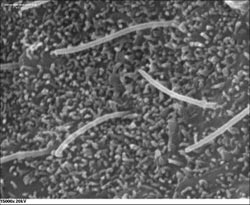Critical Protein Discovered for Healthy Cell Growth in Mammals

Using mouse models, Penn State cellular biologist Aimin Liu and his colleagues discovered a protein that is required for the growth of critical, hair-like structures called cilia on cell surfaces. The cilia on a mouse embryo, shown in this micrograph, would not be able to grow without the protein C2cd3. Credit: Aimin Liu Lab, Penn State University.<br>
The discovery has important implications for human health because lack of cilia can lead to serious diseases such as polycystic kidney disease, blindness and neurological disorders.
“If we want to better understand and treat diseases related to cilium development, we need to identify important regulators of cilium growth and learn how those regulators function,” said co-author Aimin Liu, associate professor of biology at Penn State. “This work gives us significant insight into one of the earliest steps in cilium formation.”
The researchers describe their findings in a paper that will be published online in the Proceedings of the National Academy of Sciences during the week of 27 January 2014. In addition to Liu, authors include Penn State cellular biologists Xuan Ye, Huiqing Zeng and Gang Ning, as well as Jeremy F. Reiter, a biophysicist at the University of California – San Francisco.
Cilia, which are present on the surface of almost all mammalian cells, are responsible for sending, receiving, and processing information within the body. “You could think of cilia as the cells' antennae,” Liu said. “Without cilia, the cells can't sense what's going on around them, and they can't communicate.” Cilia also perform important filtering and cleansing functions. For example, cilia inside the trachea, or windpipe, trap and prevent bacteria from entering the lungs.
In a previous study, Liu and his colleagues learned that a protein called C2cd3 is important for cilium formation because mice that lacked this protein exhibited severe developmental problems typically associated with the lack of cilia. “At the time we knew only that if we get rid of the protein, the cells in the animal would not grow cilia,” Liu said. “We didn't understand why, but now we do.”
A cilium grows from a centriole, a structure that clings to the inner surface of the cell and serves as an anchor for the cilium. Before a cell can grow a cilium, it needs to assemble a set of appendages at one end of the centriole. These appendages can then connect the centriole to the cell surface, allowing the outgrowth of a cilium. Just how these appendages are assembled, though, remained a mystery for more than four decades since their discovery in 1962.
Liu and his colleagues found that appendages were not assembled at the end of the centriole when the C2cd3 protein is not present. As a result, the centriole is not associated with the cell membrane and cannot recruit other proteins for the further growth of the cilium. “So our protein is required for the very first step of putting a cilium together,” Liu explained. “Without those appendages, the cilium growth cannot happen.”
The researchers hope their discovery will lead to greater knowledge of the process of cilium development and, eventually, to treatments for a wide range of health problems that fall under the label of ciliopathy. “Ciliopathy is a scientific term that covers a lot of diseases,” Liu said. As well as contributing to cystic disorders in the kidney and liver, lack of cilia can lead to blindness or deafness, since cilia in the retina serve as receptors that process light stimulation and cilia within the ear are required in neurons that translate sound waves into neural signals.
The research was funded by the National Institutes of Health (R01AR054396, R01GM095941), the Burroughs Wellcome Fund, the Packard Foundation, the Program for Breakthrough Biomedical Research, an American Heart Association Scientist Development Grant (0830174N) and Penn State University.
Contacts:
Aimin Liu: axl25@psu.edu, (+1) 814-865-7043
Barbara Kennedy (PIO): science@psu.edu, 814-863-4682
Media Contact
More Information:
http://www.psu.eduAll latest news from the category: Life Sciences and Chemistry
Articles and reports from the Life Sciences and chemistry area deal with applied and basic research into modern biology, chemistry and human medicine.
Valuable information can be found on a range of life sciences fields including bacteriology, biochemistry, bionics, bioinformatics, biophysics, biotechnology, genetics, geobotany, human biology, marine biology, microbiology, molecular biology, cellular biology, zoology, bioinorganic chemistry, microchemistry and environmental chemistry.
Newest articles

Bringing bio-inspired robots to life
Nebraska researcher Eric Markvicka gets NSF CAREER Award to pursue manufacture of novel materials for soft robotics and stretchable electronics. Engineers are increasingly eager to develop robots that mimic the…

Bella moths use poison to attract mates
Scientists are closer to finding out how. Pyrrolizidine alkaloids are as bitter and toxic as they are hard to pronounce. They’re produced by several different types of plants and are…

AI tool creates ‘synthetic’ images of cells
…for enhanced microscopy analysis. Observing individual cells through microscopes can reveal a range of important cell biological phenomena that frequently play a role in human diseases, but the process of…





















